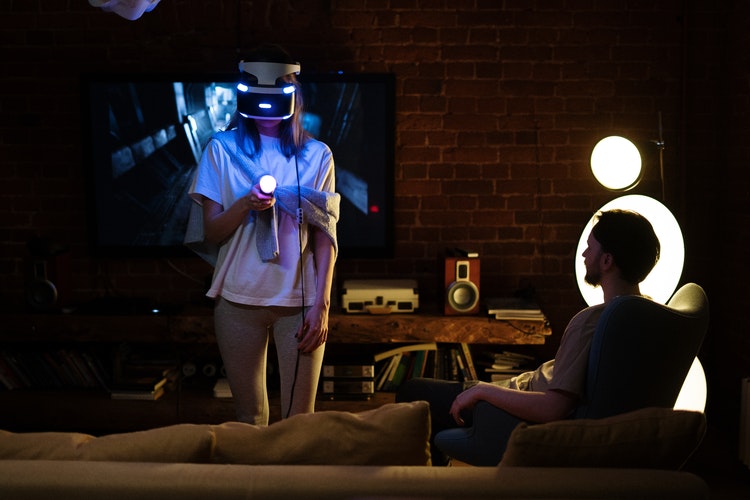The usage of AR and VR is increasing with time. The technological trends are penetrating in daily life routine. Around 40% of consumers prefer to pay more for the product that is AR/VR customized. Therefore, the market size of AR/VR is on continuous growth. See the following illustration reflecting the market size of AR/VR;
“Recently, AR/VR is being used in museums. There are a variety of museums using it for increasing engagement and attracting more tourists. ”
Let’s discuss the impact of these digital transformations on culture and the future of AV/VR in museums.
Digital and Cultural Tug of War
The digital transformations of museums are directly related to the culture. It is creating an impact on the culture and affecting the cultural tourism sites like; art galleries, museums, and cultural heritage sites.
They are using the technology to re-live the events and tour remote locations, increasing visual appeal. The core impact it creates on culture is the facilitation of artists and competitiveness of the destination.
Using the AR/VR in museums enables local and struggling artists to arrange a virtual tour of their paintings, exempting the hefty cost of art galleries. Along with this, AR/VR attracts millennial, increasing the tourism significance of that place.
“A visit to a museum is a search for beauty, truth, and meaning in our lives. Go to museums as often as you can.”– Maira Kalman”
To date, the impact of museum transformation is positive on the culture.
How They Are Using It
The museums are using AR/VR in different and unique aspects. See the following example of their usage in renowned museums.
- The Stedelijk Museum, Amsterdam, was the first place to use AR technology for virtual art tours. They also arrange an AR festival where any person can borrow an art piece from the museum (virtually) and then exhibit it for others.
- The Art Gallery of Ontario use characters from old paintings and bring them to life. They were only visible through the smartphones of the visitors.
- The FBI uses it more distinctly. They provide a VR tour to the audience to experience the working pattern of the FBI headquarters.
The VR apps in the museum can entertain, attract, and educate visitors. Though, it requires being unique and more lively. If the experience is not distinct from reality, it will not add any value to the visitors.
What’s the Future?
The rapid technological growth and convenience in adaptation have forced many business areas to adopt technological advancements. Despite its widespread popularity and demand for visitors, only a moderate number of museums are using it.
It is treated more like a fancy technology being used in large scale museums. The list only includes; The Helsinki City Museum, Norwegian Maritime Museum, the Danish Castle Centre, the Heureka Science Center and few others.
The changing trend and more economical devices are the silver lining for the future of AR/VR in museums. Following are the trend expected in museums;
-
Apple’s AR Glasses
The economic and lightweight technology is the ultimate savior of AR in the museums accompanied by voice recognition and hand tracking technologies.
It is rumored that Apple is designing new AR glasses that can support AR/VR in museums. The product is predicted to be successful due to the brand name attached to it. And the track record of the company for introducing new technologies to the masses.
The four tech giants, Facebook, Microsoft, Apple, and Google, are interested in initiating this technology that enlightens digital museums’ future. Though, it will require 5G connectivity to operate the devices.
-
Virtual Art Galleries
The AR/VR advancements will create virtual spaces for artists to exhibit their talent shortly. Artists will be facilitated to create their own gallery and interact with the visitors directly. Along with this, the audience will attend more personalized tours of the gallery from any remote location.
It will also initiate the concept of the virtual art auction and support new artists;
“”The painter will produce pictures of little merit if he takes the works of others as his standard.” ― Leonardo da Vinci”– Maira Kalman”
These virtual galleries will offer single and group tours. The 3D renditions will enable the virtual recording and meetings with the visitors.
-
Realistic Approaches
The usage of technology will enable the portrayal of historical events in a more realistic way. The British Museum has taken the first step in the initiation of this future technology. The museum has launched a VR program demonstrating the Bronze Age.
The VR will not replace the real-life experience rather add on the experience. It embeds context in the objects and facilitates it to utilize a more realistic approach. It sparks creativity among the audience, increasing their curiosity level and forcing them to visit museum repeatedly.
-
Fun Learning Lessons
The AR process will initiate the fun learning process like; future 3D or virtual education tools did. The AR in future will give life to fossils and older objects. It will include; sound, motions and visuals to make history more engaging.
The smartphones will serve as a tour guide to the visitors. They can also use it to bring an object to life.
The Smithsonian National Museum of Natural History is already using this type of technology. They provide an app to smartphone users that can add flesh and bone to any fossil in the museum.
-
Catering Millennial
The requirement of the future generation is different from the older one. The young generation does not prefer visiting museums due to the tedious experience. Numbers of them emphasize that museums should have technological advancements and engaging AR/VR facilities.
They do not prefer to stand in queue and pay for essay or any other written guiding material. One of them considers it boring and says that;
“”Even if I didn’t want to touch the Mona Lisa, I want to have the option to touch it. You go to a museum, and you’re just walking around looking at everything”- A Millennial”
Therefore, AR/VR has become necessary to save the interest of museums in the near future.
Ending Thoughts
The rapidly shifting technology is challenging cultural practices and heritage every day. The recent trend of AR/VR in museums is one of them. Though it provides befits in many aspects, some believe it is deteriorating the uniqueness and identity of a culture.
But the inclusion of these technologies is essential for retaining the attention of the young generation. The AR/VR is going wonders in the museum and provides adventurous experiences to the visitors.
I hope the reasons I have mentioned above will be enough to defend the technological change in museums. If you visit any of the mentioned places, please do tell me.
— Stella Lincoln is currently working as an Assistant Editor at academic writing services a Assignment Assistance and Dissertation Assistance.










